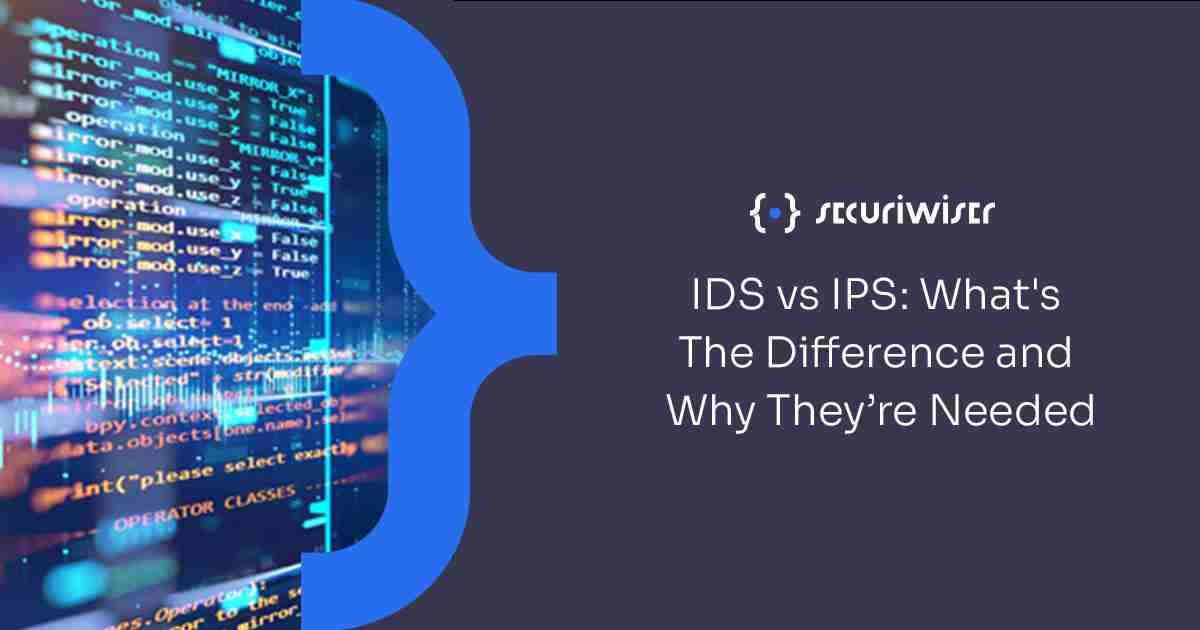IDS vs IPS: What’s the Difference and Why They’re Needed
Blog / IDS vs IPS: What’s the Difference and Why They’re Needed
4 MIN READ


IDS and IPS are both critical components of cybersecurity. In cyberspace, there are always threats and malicious actors trying to get into networks and systems by subterfuge. Time is crucial, and the faster you know that there’s a breach in your system, the better chance you have to mitigate, rebuff threat actors and recover as opposed to letting threat actors rob you blind.
With Security teams and organisations struggling against the ever-growing threats of ransomware, data breaches, cyber warfare, legal challenges and compliance fines, IDS and IPS technology can help side-step budget issues and company politics to an extent by covering specific, key jobs related to cybersecurity strategy from the get-go.
But, what exactly are IDS and IPS and how do they work?
What is an IDS?
Intrusion Detection Systems (IDS) are a network security tool which is primarily designed to detect vulnerabilities and exploits targeting servers, applications and computers of an organisation. The majority of the time, an IDS is a dedicated server connected to a port mirror configured to a core switch, with the switch forwarding a copy of all traffic flowing through it to the tool.
By default, IDS only listens to traffic. Its primary objective is to keep an ear out for any anomalies and generate an alert to an admin or analyst to let them know if something seems amiss, so that a person can evaluate and make a decision on what action to take.
Although, while IDSs don’t normally take action on what they’ve detected by default, a modern IDS can be configured to automatically run scripts that command a router to block an IP address if they detect suspicious activity coming from it.
While IDS is often network-based and hardware, it can also commonly be host-based, as in a Host-based Intrusion Detection Systems (HIDS), where a piece of software is installed on an end-point device, helping protect that device by monitoring the traffic being sent and received and flagging suspicious activity.
What is an IPS?
In contrast, an Intrusion Prevention Systems (IPS) IPS is designed to automatically take action on a detected anomaly in the network. Unlike IDS, an IPS doesn’t simply receive and listen to a copy of network traffic, but instead all traffic is directed through it before it's allowed to move onto its destination in the network and system.
IPS is usually a piece of hardware which is positioned after a router, edge device, or firewall. lt should be noted that some firewalls are even designed to function as IPSs too.
Like IDS, IPS can also be host-based software. Host-based Intrusion Prevention Systems (HIPS), actively listens to traffic, analysing events and taking appropriate action to protect the end-point devices it’s installed on.
How are IDS and IPS similar?
IDS and IPS do a lot of similar things almost to the point that they can seem a little redundant on the surface.
Both IDS and IPS can:
- Perform signature-based detection, using a database of threat signatures showing common patterns of network traffic to identify if traffic has malware.
- Do anomaly-based detection, where traffic that doesn’t follow the standard protocol raises an alert, such as a lot of half-open TCP sessions, HTTP traffic lacking the right header, etc.
- Be network or host-based.
As you can see, they can be seen as really two sides of the same coin in a way, with just a few key differences here and there. Unsurprisingly, the advantages of these systems for cybersecurity follow a similar pattern, as both IDS and IPS can help organisations with:
- Automation, as IDS and IPS systems largely perform their processes automatically. IPS goes the extra mile of even defending the system without human intervention.
- Auditing Data, as IDS and IPS are great for auditing data, which is an important aspect of compliance investigations.
- Compliance in general, as by implementing an IDS and IPS, you are addressing a number of CIS Security controls, proving your organisation is investing in technology and systems to protect data, which is all important to meeting Compliance objectives.
- Policy Enforcement, as IDS and IPS can be configured to assist in enforcing internal security policies on a network and flag/block traffic that doesn’t conform to policies.
Which is better?
Considering how similar they are, with only a few key differences, adoption by a company mostly depends on what’s the best fit for their systems and cybersecurity policies really.
Intrusion Prevention System (IDS) seems like the obvious choice at first with its ability to take action and block anomalies it views as a threat. Certainly, with malware attacks getting increasingly faster these days, a fast, no-nonsense response could be ideal for environments where any intrusion is devastating, like a database with PIIs suffering a data breach.
However, the disadvantage of IPS is that, as all traffic must pass through it, it can add a delay to network traffic flow. Moreover, at times, it can even block legitimate traffic due to false positives.
For systems that require high availability, an Intrusion Detection System (IDS) can be the better fit. Systems linked to critical infrastructure like industrial control systems (ICS), which practically always need to be kept running, would probably prefer a human operator, that would be aware of all the consequences, to evaluate the best course of action over a piece of technology automatically sticking its foot in it.
But this isn’t always an either or, in fact, since IDS and IPS can work together, depending on your systems and what you need, you could ideally need both IDS and IPS. In fact, as a general rule of thumb, the more layered and robust your security, the better.
Securiwiser
Securiwiser is a security monitoring tool which greatly complements IDS and IPS technology.
Securiwiser evaluates your company’s cybersecurity posture and flags up vulnerabilities and exploits in real-time, displaying them in an easy-to-read dashboard. It checks anomalous port activity, the security of your network and cloud, if there’s malware on your network, if there’s misconfigurations with your S3 bucket, and much more.
How secure is
your business?
Blog categories
How secure is
your business?